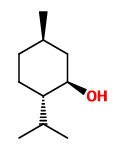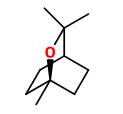Benutzer-Werkzeuge
Mentha × piperita L. - Lamiaceae - peppermint, Pfefferminze
Perennial herb, 30-90cm tall, branched, native to Europe and the Middle East, cultivated worldwide; leaves lanceolate to ovate-lanceolate, margin unequally acute serrate; flower: calyx tubular, tinged purple, puberulent or subglabrous, corolla four-lobed, white to pink, tube nearly as long as calyx.
„Source of peppermint oil, an essential oil used for flavoring confectionary, candies, liqueur, and chewing gum. The dried plant is used medicinally as a carminative, nervine, and stimulant, while menthol is used in nasal sprays. A hybrid: Mentha aquatica Linnaeus X M. spicata Linnaeus.“ http://efloras.org/florataxon.aspx?flora_id=2&taxon_id=210001264
The most potent odorants (highest FD factor, 8-12) of a Japanese peppermint oil (Yakima) were menthofuran (5.0%, rubbery tarry plastic), 1,8-cineole (4.0%, cooling eucalyptus), 2- and 3-methylbutanal (0.07%, sweet cocoa malty), pulegone (1.9%, heavy minty dirty), (E)-ß-damascenone (trace, fruity woody berry), α-pinene (0.7%, piney), 2,5-diethyltetrahydrofuran (0.02%, pungent solvent ether), ethyl 2-methylbutyrate (fruity green apple), ethyl 3-methylbutyrate (fruity strawberry), isomenthone (3.2%, minty dirty leafy), menthol (41.6%, cooling minty clean), linalool (0.3%, floral sweet creamy), ß-ionone (heavy woody fruity), and (E,Z)-2,6-nonadienal (leafy floral cucumber).
[Benn, Scot. „Potent odorants in peppermint and cornmint oils characterized by GC-O and AEDA.“ Perfumer & flavorist 23.5 (1998): 5-16]
Superior qualities of M.piperita essential oil are due to the optimal concentration of menthol and menthyl acetate and the low amount of menthofuran (trace).
[Essential oil composition of Mentha x piperita L. from different environments of north India. Shahi, A. K., Chandra, S., Dutt, P., Kaul, B. L., Tava, A., Avato, P., Flavour and fragrance journal, Vol.14(1), 1999, 5-8]
„In the search for sustainable agricultural methods for industrial crops, peppermint (Mentha piperita) was strip intercropped with soybean (Glycine max). Intercropping peppermint with soybean resulted in yield and quality increases in the essential oil, compared to sole peppermint cultivation. The yield was higher by about 50% on an equal land area basis and higher percentages of menthol and lower percentages of menthofuran and menthyl acetate improved the quality of the oil.“
[Essential oil yield in peppermint/soybean strip intercropping. Maffei, M., Mucciarelli, M., Field crops research, Vol.84(3), 2003, 229-240]
As shown by GC-MS of diethyl ether extracts, monoterpene composition changed dramatically during leaf development in peppermint. From day 5-30, menthon was the main constituent (up to 75%), with high pulegone (up to 21%) and menthofuran (4%) levels. At day 55, menthol was the main constituent (54%), 1,8-cineole rised to 15%; pulegone and menthofuran were only present in 0.8%/traces.
[Regulation of monoterpene accumulation in leaves of peppermint., Gershenzon, J., McConkey, M.E., Croteau, R.B., Plant Physiology, 122(1), 2000, 205-214] http://www.plantphysiol.org/content/122/1/205.full
„The chromatogram of peppermint essential oil is characterized by four large peaks for menthol, menthone, menthyl acetate, and eucalyptol, with smaller abundances of menthofuran, isomenthone, neomenthol, limonene, and pulegone… Peppermint lacked the presence of detectable levels of linalool and several carvyl compounds, such as dihydrocarvone (cis and trans), carveol, and dihydrocarvyl acetate, which are found in spearmint, whereas menthofuran was detected in peppermint but not spearmint. Using area percent as a semi-quantitative means of comparing the relative amounts of essential oil constituents, both menthol and menthone were found to be about twice as abundant in peppermint as spearmint. In addition, menthyl acetate in peppermint was about four times greater than in spearmint. Carvone, on the other hand, was about 350 times higher in spearmint
than in peppermint. Another striking difference involves the ratio between limonene and eucalyptol. The ratio in peppermint was 1:2.5, whereas in spearmint it was almost 50:1. These characteristics provide means of differentiating the two oils.“
[Application of Comprehensive Two-Dimensional Gas Chromatography (GC× GC) to the Qualitative Analysis of Essential Oils. Dimandja, J. M. D., Stanfill, S. B., Grainger, J., Patterson Jr, D. G., Journal of High Resolution Chromatography, Vol.23(3), 2000, 208-214]
„(+)-Pulegone is a central intermediate in the biosynthesis of (-)-menthol, the most significant component of peppermint essential oil. Depending on environmental conditions, this branch point metabolite may be reduced to (-)-menthone en route to menthol, by pulegone reductase (PR), or oxidized to (+)-menthofuran, by menthofuran synthase.“
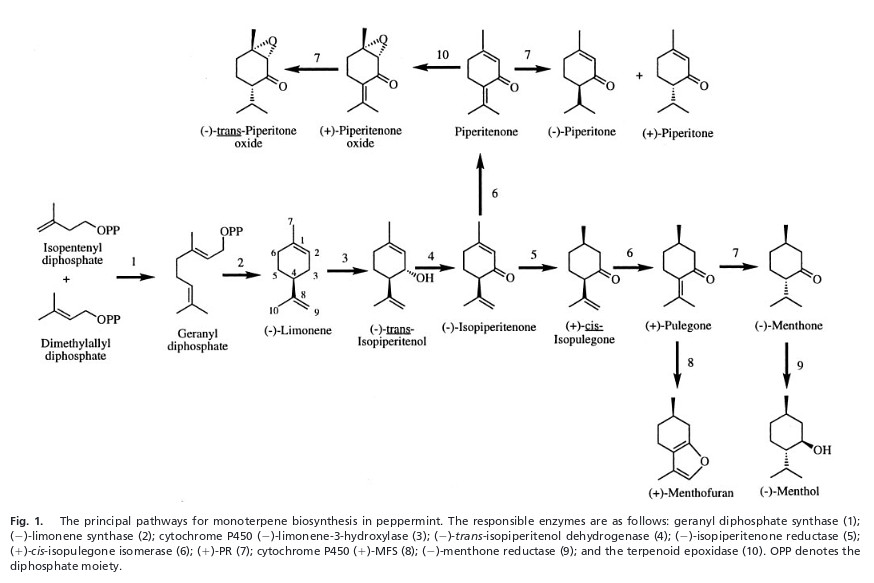 [Menthofuran regulates essential oil biosynthesis in peppermint by controlling a downstream monoterpene reductase. Mahmoud, S. S., Croteau, R. B., Proceedings of the National Academy of Sciences, Vol.100(24), 2003, 14481-14486]
http://www.pnas.org/content/100/24/14481.full.pdf
[Menthofuran regulates essential oil biosynthesis in peppermint by controlling a downstream monoterpene reductase. Mahmoud, S. S., Croteau, R. B., Proceedings of the National Academy of Sciences, Vol.100(24), 2003, 14481-14486]
http://www.pnas.org/content/100/24/14481.full.pdf
„Peppermint (Mentha × piperita L.) was transformed with various gene constructs to evaluate the utility of metabolic engineering for improving essential oil yield and composition… The most promising results were obtained by transforming plants expressing an antisense version of (+)-menthofuran synthase, which is critical for adjusting the levels of specific undesirable oil constituents, with a construct for the overexpression of the MEP pathway gene 1-deoxy-D-xylulose 5-phosphate reductoisomerase (up to 61% oil yield increase over wild-type controls with low levels of the undesirable side-product (+)-menthofuran and its intermediate (+)-pulegone). Elite transgenic lines were advanced to multiyear field trials, which demonstrated consistent oil yield increases of up to 78% over wild-type controls and desirable effects on oil composition under commercial growth conditions. The transgenic expression of a gene encoding (+)-limonene synthase was used to accumulate elevated levels of (+)-limonene, which allows oil derived from transgenic plants to be recognized during the processing of commercial formulations containing peppermint oil. Our study illustrates the utility of metabolic engineering for the sustainable agricultural production of high quality essential oils at a competitive cost.“
[Improving peppermint essential oil yield and composition by metabolic engineering. Lange, B. M., Mahmoud, S. S., Wildung, M. R., Turner, G. W., Davis, E. M., Lange, I., Croteau, R. B., Proceedings of the National Academy of Sciences, Vol.108(41), 2011, 16944-16949]
The major volatiles from aqueous extract of peppermint commercial sachets (analysed with SPME/GC-MS) were terpenoids (275-382 µg/l, respectively): eucalyptol, linalool, menthol, citral, o-ocimenol, α-terpineol, dihydrocarveol-acetate, carvone, spathulenol, α-bisobololoxide B, dihydroactinidiolide.
[Volatile composition of peppermint (Mentha piperita L.) commercial teas through solid phase extraction., Riachi, L.G., Abi-Zaid, I.E., Moreira, R.F., De Maria, C.A., Archivos latinoamericanos de nutricion, Vol.62(4), 2012, 389-392]
http://www.scielo.org.ve/pdf/alan/v62n4/art11.pdf
A randomized double-blind, double-dummy, controlled trial was conducted in 100 patients showed that „… Peppermint oil solution administered intraluminally can be used as an antispasmodic agent with superior efficacy and fewer side effects than hyoscine-N-butylbromide administered by intramuscular injection during upper endoscopy.“
[Peppermint oil reduces gastric spasm during upper endoscopy: a randomized, double-blind, double-dummy controlled trial., Hiki, N., Kurosaka, H., Tatsutomi, Y., Shimoyama, S., Tsuji, E., Kojima, J., Mafune, K.I., Gastrointestinal endoscopy, 57(4), 2003, 475-482]
„Peppermint (Mentha piperita L.) is one of the most widely consumed single ingredient herbal teas, or tisanes. Peppermint tea, brewed from the plant leaves, and the essential oil of peppermint are used in traditional medicines. Evidence-based research regarding the bioactivity of this herb is reviewed. The phenolic constituents of the leaves include rosmarinic acid and several flavonoids, primarily eriocitrin, luteolin and hesperidin. The main volatile components of the essential oil are menthol and menthone. In vitro, peppermint has significant antimicrobial and antiviral activities, strong antioxidant and antitumor actions, and some antiallergenic potential. Animal model studies demonstrate a relaxation effect on gastrointestinal (GI) tissue, analgesic and anesthetic effects in the central and peripheral nervous system, immunomodulating actions and chemopreventive potential. Human studies on the GI, respiratory tract and analgesic effects of peppermint oil and its constituents have been reported. Several clinical trials examining the effects of peppermint oil on irritable bowel syndrome (IBS) symptoms have been conducted. However, human studies of peppermint leaf are limited and clinical trials of peppermint tea are absent. Adverse reactions to peppermint tea have not been reported, although caution has been urged for peppermint oil therapy in patients with GI reflux, hiatal hernia or kidney stones.“
[A review of the bioactivity and potential health benefits of peppermint tea (Mentha piperita L.). McKay, D. L., Blumberg, J. B., Phytotherapy Research, Vol.20(8), 2006, 619-633]
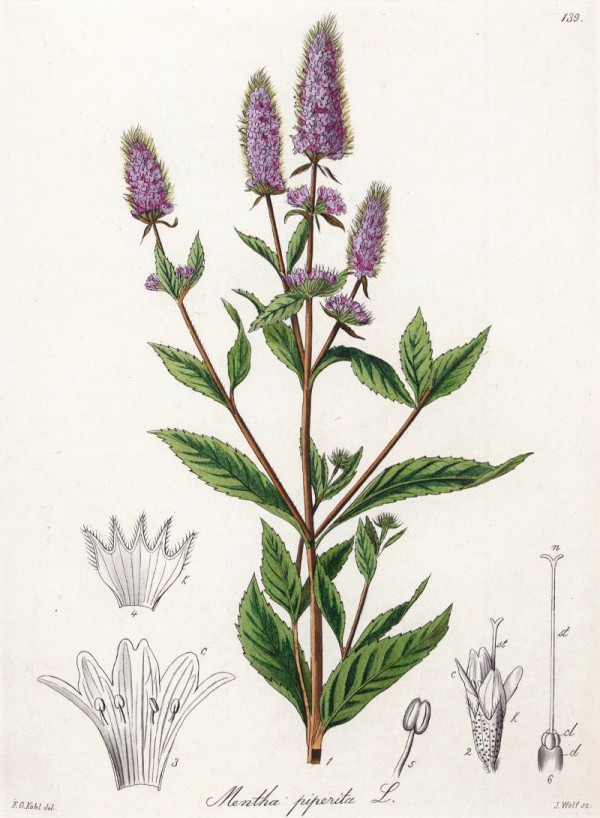
Kohl, F.G., Die officinellen Pflanzen der Pharmacopoea Germanica, t.139 (1891-1895) [F.G.Kohl]
http://plantgenera.org/species.php?id_species=659334
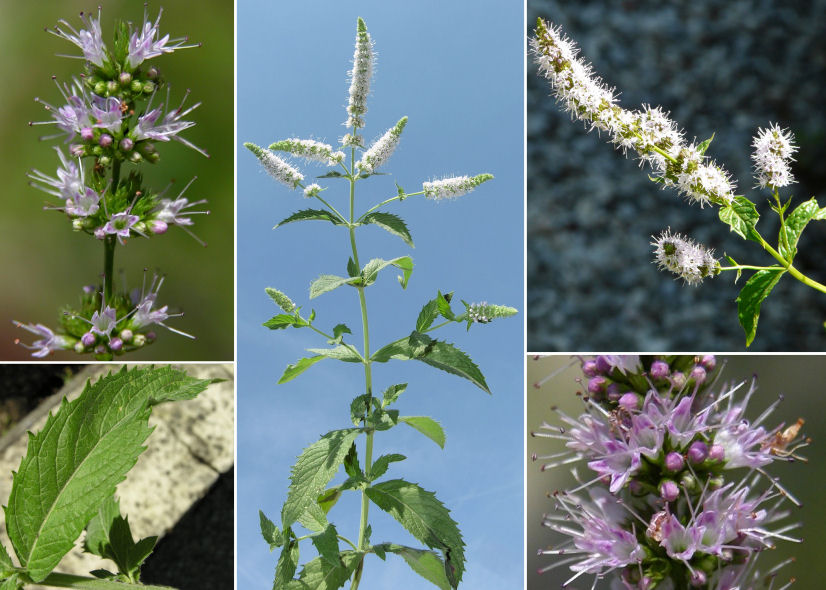
Mentha × piperita L. © Dipartimento di Scienze della Vita, Università di Trieste; picture by Andrea Moro
CC BY-SA 4.0, https://dryades.units.it/Roma/index.php?procedure=taxon_page&id=4651&num=5296

